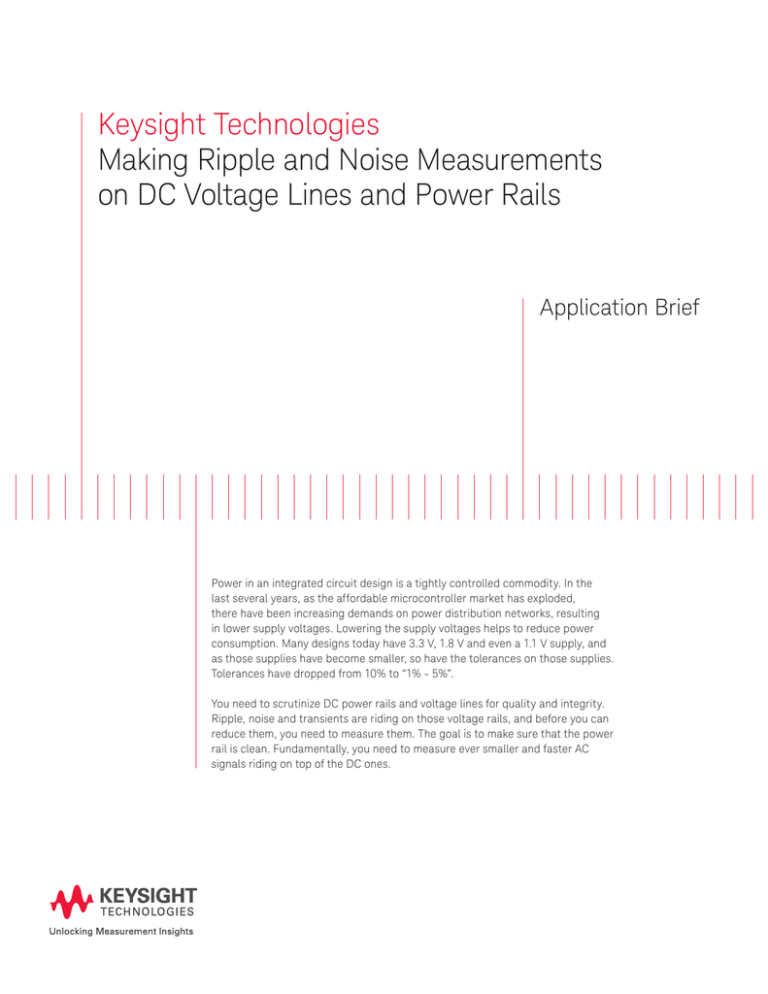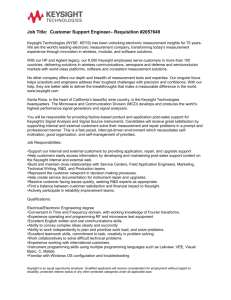Keysight Technologies Making Ripple and Noise Measurements on
advertisement

Keysight Technologies Making Ripple and Noise Measurements on DC Voltage Lines and Power Rails Application Brief Power in an integrated circuit design is a tightly controlled commodity. In the last several years, as the affordable microcontroller market has exploded, there have been increasing demands on power distribution networks, resulting in lower supply voltages. Lowering the supply voltages helps to reduce power consumption. Many designs today have 3.3 V, 1.8 V and even a 1.1 V supply, and as those supplies have become smaller, so have the tolerances on those supplies. Tolerances have dropped from 10% to “1% - 5%”. You need to scrutinize DC power rails and voltage lines for quality and integrity. Ripple, noise and transients are riding on those voltage rails, and before you can reduce them, you need to measure them. The goal is to make sure that the power rail is clean. Fundamentally, you need to measure ever smaller and faster AC signals riding on top of the DC ones. 02 | Keysight | Making Ripple and Noise Measurements on DC Voltage Lines and Power Rails - Application Brief Challenge: Measure small AC signals on top of relatively large DC signals In your circuit, you have a DC signal and a tolerance band around the top of that DC signal (Figure 1). So, as long as you stay inside the tolerance band, your power distribution network (PDN) will pass, and if you go outside the tolerance band, it will fail, in which case, you will have to reduce the noise. In either case you have to be able to see and measure the AC signal that is riding on top of the DC signal. This application brief is designed to help you get the very best measurement of that AC signal. Tolerance band + DC Figure 1. In order to solve the challenge of measuring small AC signals on top of large DC signals is it critical to overcome the impacts of measurement system noise and large signal offset. Choose the lowest noise oscilloscope measurement path You want the noise of your oscilloscope measurement system to be as small as possible so as to not overshadow your results. Hint 1: Use 1:1 probe Oscilloscope probes come in a variety of attenuation ratios. The ratio defines how much the signal is divided down before being viewed on the screen. For example a 10:1 probe allows you to measure signals that otherwise would exceed the maximum input to the scope. The downside of attenuation is that the size of the scope noise relative to the size of the signal being measured increases as well. In Figure 2, a 10:1 probe and a 1:1 probe are measuring the same 20 MHz 50 mV p-p sine wave. The 10:1 probe overstates the measurement by at least 25% due to the reduced signal-to-noise ratio resulting from the higher attenuation ratio. The 1:1 probe more accurately measures the signal when noise can be problematic. 1:1 probe 52 mVpp 10:1 probe 65 mVpp Figure 2. Noise comparison of a 1:1 and 10:1 probe measuring a 50 Vp-p sine wave Hint 1 When measuring small signals where oscilloscope and probe noise can be problematic, it is best to use as small an attenuation ratio as possible. 03 | Keysight | Making Ripple and Noise Measurements on DC Voltage Lines and Power Rails - Application Brief Hint 2: Use 50 Ω input path of the oscilloscope The oscilloscope measurement path includes the oscilloscope being used, the scope input termination (either 50 Ω or 1 MΩ) and the probe that accesses the signal. For many oscilloscopes, the 50 Ω input is a lower-noise path than the 1 MΩ input termination path. Figure 3 shows the baseline noise of the 50 Ω input and 1 MΩ input. The 50 Ω (yellow) clearly is smaller and in this case the better choice. Check the noise of the input terminals of your oscilloscope by configuring it and the probes as you intend to use them when making your supply noise measurement, then short the input to ground (or short the inputs together on a differential probe) and measure the baseline noise. Hint 2 Use the lowest oscilloscope noise input path. Often this is the 50 Ω input. 50 Ω input: Vpp = 573 µV, Vrms = 74 µV 1 MΩ input: Vpp = 2030 µV, Vrms = 271 µV Figure 3. Baseline noise on the 50 Ω input compared to 1 MΩ input path of the oscilloscope. Hint 3: Use probe offset to increase dynamic range Ripple and noise on the DC power supply is mostly likely small compared to the DC signal, resulting in a small AC signal riding on top of a relatively large DC signal. Offset is a feature in some oscilloscopes and active probes that enables you to remove DC content from signals being measured. Figure 4 shows the noise measurement results on a 1.8 V supply with and without the use of probe offset. Hint 3 Use probe offset to zoom in on the small AC signal. Although most active probes provide offset, they also have large attenuation ratios, which increases the oscilloscope measurement system noise. And while a DC block can block DC content, it can also block low frequency content in the signal. No offset: 105 mVpp 4a 1.8 V offset: 83 mVpp 4b Figures 4a and 4b. Measuring the noise on a 1.8 V DC supply with no offset and with the use of probe offset. 04 | Keysight | Making Ripple and Noise Measurements on DC Voltage Lines and Power Rails - Application Brief Hint 4: Minimize oscilloscope and probe loading of the supply Any time an oscilloscope probes a system, it becomes part of that system due to the electrical contact being made. This contact changes the behavior of the system being measured by creating an additional path to ground.. When measuring small signals, one goal is to minimize this loading from the measurement system as much as possible. In the context of measuring DC supplies, a common source of excessive loading happens when a user attaches a 50 Ω coaxial cable to the supply and to the 50 Ω input of the oscilloscope. Figure 5 shows a comparison of power rail measurements. First, the power rail was measured by a DMM with a result of 3.31 V. Next, the supply was probed with a 50 kΩ input impedance, still resulting in 3.31 V. Finally, the supply was probed by connecting directly to the 50 Ω oscilloscope input, and the supply dropped from 3.31 V to 3.25 V. Some supplies will have enough excess capacity to drive this additional load but some will not. This additional load could affect the behavior of the power management IC. Hint 4 Use a probe with a high input impedance to minimize excess load on the circuit being tested. 50 Ω cable to oscilloscope (50 Ω at DC) N7020A 50 kΩ at DC 5a 5b DCVrms = 3.31 V 3.61 V DCVrms = 3.25 V 3.13 V 2.63 V 3.40 V 3.20 V Note: 50 Ω at DC pulled this supply down ~60 mV (changed the target this much) 3.00 V Figures 5a and 5b. Comparison of noise on 3.3 V power rail measurements, showing input impedance of 50 kΩ on the left and input impedance of 50 Ω on the right. 05 | Keysight | Making Ripple and Noise Measurements on DC Voltage Lines and Power Rails - Application Brief The N7020A power rail probe combined with the Infiniium S-Series oscilloscope The previously mentioned hints will help minimize oscilloscope measurement system noise and will help identify sources of noise and ripple in a DC power supply, no matter what brand of oscilloscope you use. These techniques work even better when they are used with specialized tools that are designed to measure power supply noise. The N7020A power rail probe (Figure 6) is the first probe that is specifically designed for measuring noise on DC power supplies. It has a 1:1 attenuation ratio, ± 24 V of offset and a 50 kΩ input impedance. When used with the Keysight Infiniium S-Series oscilloscope, the N7020A has 2 GHz bandwidth to capture high-frequency noise and transients that can cause clock and data jitter. With Keysight’s N7020A power rail probe and the Infiniium S-Series oscilloscope, you can more easily find and analyze the AC signals of your DC power supply that you were unable to see before – giving you the measurement insight that you need. Related Literature Making Your Best Power Integrity Measurement - Application Note, www.keysight.com/find/powerintegrity-guide The 10-bit Infiniium S-Series paired with the Keysight N7020A power rail probe,creates a measurement system specifically designed for measuring noise on DC power supplies. The Keysight N7020A power rail probe is the first probe that is specifically designed for measuring noise on DC power supplies. Infiniium S-Series oscilloscope ordering information Power rail probe ordering information –– 500 MHz - 8 GHz bandwidth (upgradeable) –– 20 GSa/s sampling, up to 800 Mpts memory –– 16 Ch logic channel, serial data analysis –– 50 kΩ DC input impedance –– ± 24 V DC offset range –– 1:1 attenuation Product Bandwidth CH Product Bandwidth DSOS204A 2 GHz 4 N7020A 2 GHz 06 | Keysight | Making Ripple and Noise Measurements on DC Voltage Lines and Power Rails - Application Brief From Hewlett-Packard through Agilent to Keysight For more than 75 years, we‘ve been helping you unlock measurement insights. Our unique combination of hardware, software and people can help you reach your next breakthrough. Unlocking measurement insights since 1939. 1939 THE FUTURE myKeysight www.keysight.com/find/mykeysight A personalized view into the information most relevant to you. Three-Year Warranty www.keysight.com/find/ThreeYearWarranty Keysight’s committed to superior product quality and lower total cost of ownership. Keysight is the only test and measurement company with three-year warranty standard on all instruments, worldwide. And, we provide a full one-year warranty on all accessories, calibration devices, systems and custom products. Keysight Assurance Plans www.keysight.com/find/AssurancePlans Up to five years of protection and no budgetary surprises to ensure your instruments are operating to specification so you can rely on accurate measurements. For more information on Keysight Technologies’ products, applications or services, please contact your local Keysight office. The complete list is available at: www.keysight.com/find/contactus Americas Canada Brazil Mexico United States (877) 894 4414 55 11 3351 7010 001 800 254 2440 (800) 829 4444 Asia Pacific Australia China Hong Kong India Japan Korea Malaysia Singapore Taiwan Other AP Countries 1 800 629 485 800 810 0189 800 938 693 1 800 11 2626 0120 (421) 345 080 769 0800 1 800 888 848 1 800 375 8100 0800 047 866 (65) 6375 8100 Europe & Middle East Austria Belgium Finland France Germany Ireland Israel Italy Luxembourg Netherlands Russia Spain Sweden Switzerland Keysight Infoline www.keysight.com/find/service Keysight’s insight to best in class information management. Free access to your Keysight equipment company reports and e-library. United Kingdom Keysight Channel Partners www.keysight.com/find/channelpartners Get the best of both worlds: Keysight’s measurement expertise and product breadth, combined with channel partner convenience. (BP-07-24-15) www.keysight.com/find/switch2sseries 0800 001122 0800 58580 0800 523252 0805 980333 0800 6270999 1800 832700 1 809 343051 800 599100 +32 800 58580 0800 0233200 8800 5009286 800 000154 0200 882255 0800 805353 Opt. 1 (DE) Opt. 2 (FR) Opt. 3 (IT) 0800 0260637 For other unlisted countries: www.keysight.com/find/contactus www.keysight.com/go/quality Keysight Technologies, Inc. DEKRA Certified ISO 9001:2008 Quality Management System This information is subject to change without notice. © Keysight Technologies, 2015 Published in USA, September 30, 2015 5992-0946EN www.keysight.com





